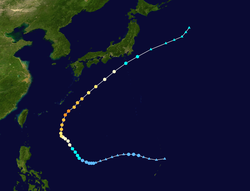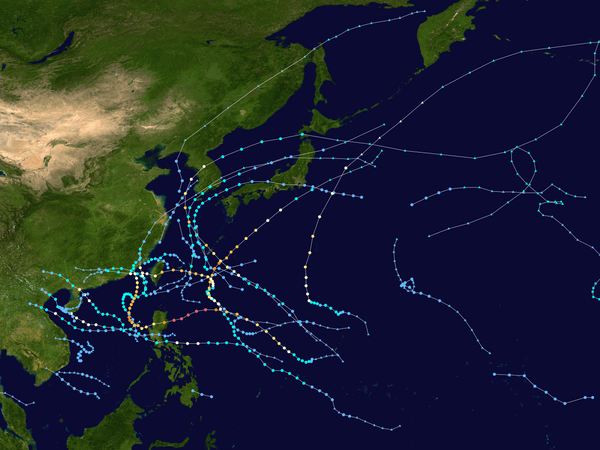Typhoon Chaba (2010)
Typhoon Chaba, known in the Philippines as Typhoon Katring, was the first typhoon to impact Japan since Typhoon Melor in October 2009. Chaba means Hibiscus in Thai.[1]
| Typhoon (JMA scale) | |
|---|---|
| Category 4 typhoon (SSHWS) | |
 Typhoon Chaba near peak strength off the Ryukyu Islands on 28 October | |
| Formed | 20 October 2010 |
| Dissipated | 1 November 2010 |
| (Extratropical after 30 October) | |
| Highest winds | 10-minute sustained: 175 km/h (110 mph) 1-minute sustained: 215 km/h (130 mph) |
| Lowest pressure | 930 hPa (mbar); 27.46 inHg |
| Fatalities | None reported |
| Areas affected | Japan |
| Part of the 2010 Pacific typhoon season | |
Meteorological history

Early on 20 October, the Japan Meteorological Agency (JMA) upgraded an area of low pressure into a tropical depression.[2] Later that day, the JMA reported that the tropical depression slightly intensified.[3] The next day, the Joint Typhoon Warning Center started monitoring the system as tropical depression 16W.[4] On 23 October, the system entered the Philippine Area of responsibility and the Philippine Atmospheric, Geophysical and Astronomical Services Administration (PAGASA) started monitoring the system as Tropical Depression "Katring"[5] On 24 October, the JMA and JTWC upgraded the tropical depression into a tropical storm and the JMA named it "Chaba".[6][7] On 25 October, the JMA further upgraded the storm into a Severe Tropical Storm.[8] Later that day, the JTWC upgraded the storm into a Category 1 Typhoon.[9] Early on 26 October, the JMA further upgraded the storm into a Typhoon.[10] Early on 27 October, the JTWC upgraded the typhoon into a Category 2 Typhoon.[11] Later that day, the JTWC further upgraded the typhoon into a Category 3 Typhoon.[12] The following day JTWC upgraded the system into a Category 4 Typhon.[13] Later that day, the JTWC downgraded Chaba into a Category 3 Typhoon.[14] Early on 29 October, the JTWC further downgraded Chaba into a Category 2 Typhoon, while the JTWC downgraded it into a Category 1 Typhoon.[15] Early on 30 October, the JTWC reported that Chaba had transitioned into an extratropical cyclone. During the afternoon of 30 October, the JMA downgraded Chaba to a remnant low as passed near Japan. The remnants of Chaba continued to weaken as it moved northeast, but strengthened again in approaching the Gulf of Alaska into a major storm[16] with 55-knot winds,[17] kicking up 40–50 foot waves, with pressure as low as 939 mb.[18] The storm's center came ashore in the vicinity of Cordova, Alaska on 1 November, but not before pulling an atmospheric river of moisture into the American Pacific Northwest, setting a record[19] for that date of precipitation in Seattle.
Preparations and impact
In preparation for Chaba, more than 160 flights were cancelled.[20] Islanders in southern Japan started sandbagging doors and reinforcing windows as Chaba churned closer.[21] Strong winds and heavy rains lashed through Okinawa and there were a lot of concerns about the island of Amami which was in the typhoon's path.[22] Over 257 residents were evacuated from the Amami Islands to higher grounds, schools and town halls which were converted into evacuation centers.[1] Late on 29 October, Chaba approached Amami island region in Kagoshima. Strong winds injured five people and felled electric poles cutting electricity supply.[23] Landfall was predicted on the main island of Honshu.[24]
On Minami-Daito Island in Okinawa Prefecture, winds from the typhoon gusted up to 160 km/h (99 mph), resulting in roughly 500 residences losing power. Five people were also injured across the island.[23] Chaba dumped nearly 50 mm (2.0 in) of rain per hour across southern Japan. The Japan Racing Association postponed races in Tokyo until 1 November because of the typhoon.[25]
Retirement and naming issues
The name Katring has been used several times by PAGASA, but after 2010 the name Katring was decommissioned from the rotating lists, possibly due to the storm of the same name that caused destruction in parts of Luzon in 1994. It was eventually replaced by the name Kanor, which drew controversy as it is coincidentally the name of a person who was involved in a sex scandal a few years prior. The name Kanor was later changed to Karding.[26]
References
- "Japan evacuates islands as typhoon nears". Fairfax Media. 29 October 2010. Retrieved 29 October 2010.
- "JMA Tropical Weather Outlook for Pre-Tropical Depression 16W". Japan Meteorological Agency. Archived from the original on 19 October 2011. Retrieved 23 October 2010.
- "JMA Tropical Weather Outlook for Pre-Tropical Depression 16W". Japan Meteorological Agency. Archived from the original on 19 October 2011. Retrieved 23 October 2010.
- "JTWC Tropical Depression 16W Warning 01". Joint Typhoon Warning Center. Archived from the original on 7 September 2015. Retrieved 25 October 2010.
- "PAGASA Tropical Depression Katring Advisory 01". Philippine Atmospheric, Geophysical and Astronomical Services Administration. Archived from the original on 23 October 2010. Retrieved 24 October 2010.
- "JMA Tropical Cyclone Advisory 241200 on Tropical Storm Chaba". Japan Meteorological Agency. Archived from the original on 9 September 2015. Retrieved 25 October 2010.
- "JTWC Tropical Storm Chaba Warning 13". Joint Typhoon Warning Center. Archived from the original on 7 September 2015. Retrieved 25 October 2010.
- "JMA Tropical Cyclone Advisory 250600 on Severe Tropical Storm Chaba". Japan Meteorological Agency. Archived from the original on 9 September 2015. Retrieved 25 October 2010.
- "JTWC Typhoon 16W Warning 18". Joint Typhoon Warning Center. Archived from the original on 7 September 2015. Retrieved 27 October 2010.
- "JMA Tropical Cyclone Advisory 260000 for Typhoon Chaba". Japan Meteorological Agency. Archived from the original on 9 September 2015. Retrieved 26 October 2010.
- "JTWC Typhoon 16W Warning 22". Joint Typhoon Warning Center. Archived from the original on 7 September 2015. Retrieved 27 October 2010.
- "JTWC Typhoon 16W Warning 24". Joint Typhoon Warning Center. Archived from the original on 7 September 2015. Retrieved 27 October 2010.
- "Typhoon 2000". Typhoon 2000. Retrieved 28 October 2010.
- "JTWC Typhoon Chaba Warning 29". Joint Typhoon Warning Center. Archived from the original on 7 September 2015. Retrieved 28 October 2010.
- "JTWC Typhoon Chaba Warning 31". Joint Typhoon Warning Center. Archived from the original on 29 October 2010. Retrieved 29 October 2010.
- "Major Rain And Flooding Event". Cliff Mass weather blog. Retrieved 2 November 2010.
- "Update". Cliff Mass weather blog. Retrieved 2 November 2010.
- "Less Flooding Risks". Cliff Mass weather blog. Retrieved 2 November 2010.
- Kimball, Jill (1 November 2010). "Monday's rain set a record for Nov. 1". The Seattle Times. Retrieved 2 November 2010.
- "More than 160 flights cancelled as Typhoon Chaba heads for Okinawa". MediaCorp Press. Retrieved 29 October 2010.
- "Strong typhoon churns toward Japan". Agence France-Presse. Retrieved 29 October 2010.
- Ballion, Susan. "Japan issues weather warnings". InsideJapan Tours. Retrieved 29 October 2010.
- Staff Writer (29 October 2010). "Strong typhoon approaches rain-hit Amami region". The Mainichi Daily News. Archived from the original on 30 October 2010. Retrieved 31 October 2010.
- Staff Writer. "Strong typhoon heading toward disaster-struck Amami islands". THE MAINICHI NEWSPAPERS. Retrieved 29 October 2010.
- Hur, Jae (29 October 2010). "Chaba Weakens Over Japan, Downgraded to Tropical Storm as It Nears Tokyo". Bloomberg. Retrieved 30 October 2010.
- Speta, Robert (2 September 2014). "What is a Typhoon Name? PAGASA Censors "Kanor"". Western Pacific Weather. Archived from the original on 10 April 2015. Retrieved 24 January 2015.
External links
| Wikimedia Commons has media related to Typhoon Chaba (2010). |
- JMA General Information of Typhoon Chaba (1014) from Digital Typhoon
- The JMA's Best Track Data on Typhoon Chaba (1014) (in Japanese)
- The JMA's RSMC Best Track Data (Graphics) on Typhoon Chaba (1014)
- The JMA's RSMC Best Track Data (Text)
- The JTWC's Best Track Data on Typhoon 16W (Chaba)
- 16W.CHABA from the U.S. Naval Research Laboratory
